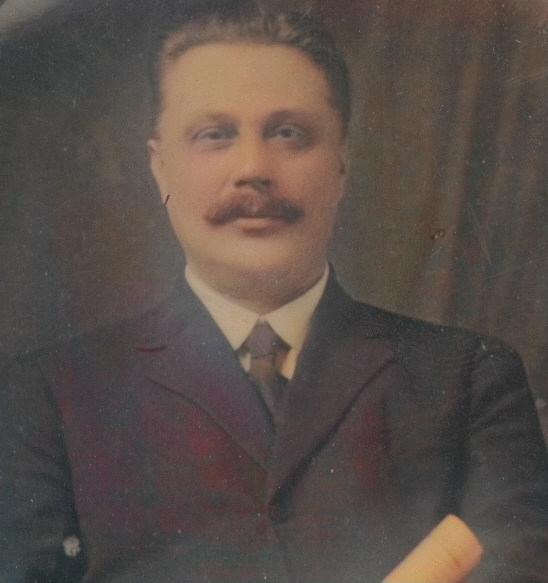Genealogy – sKALSKI’s FAMILY ROOTS from 18th c POLAND to Bronislaw Kalski move to AMERICA – The Family Story And Virtual Tour with Family Churches
BRONISLAW KALSKI’s FAMILY ROOTS FROM THE 18th CENTURY POLAND TO AMERICA – THE STORY AND VIRTUAL TOUR WITH FAMILY CHURCHES
Let’s begin our journey with the name Kalski. In the Polish etymological books, the Kalski family name story begins at least in the 14th century (1300-1399). If with the family name is Kalski (noted in old Poland from the year 1393) then all descendants with the name Kalski are derived from the family birthplace named ” Kał”, which no longer exist but was located in the central part of Poland in the Radom district. Part of the genealogy research revealed some of the Kalski descendants spelled their name sKalski . If the family name is Skalski (noted in old Poland from the year 1372), their name was derived from the family birthplace in old Poland named ” Skała “. The current genealogical records available show the family name was sKalski until 1815 when the spelling became Kalski . No one is quite certain why the name interchanged but the most likely explaination has to do with the person entering the birth, marriage and/or death records; in many cases the priest who witnessed the ceremony.
My oldest known Polish sKalski relatives, my 5th great-grandparents; Maciej sKalski and Katarzyna Janiszewska. I speculate that they met in or around Rybitwa because they were married there in February 1780 and as a peasant farmer, made their home in Rybitwa, Leoncin, Mazowieckie. Their first child, Thadeus, was born on Sunday, 29 October 1780. This is the reference on Geneteka under Mazowieckie which is referenced as follows:
“Year 1780 born Tadeusz Skalski father Maciej Skalski and Katarzyna Janiszewska parish/church Leoncin place Rybitwa”
Here is the picture of the family church at this Leoncin:
Church of St. Margaret of the Virgin and Martyr in Leoncin
Between 1781 and 1784, Maciej and Katarzyna moved to Kampinos located in Zamosc, the central part of Poland. Kampinos is in the heart of the Puszcza Kampinowska (Kampinowska Deep Forest), located just on the northern border of the capital of Poland Warsaw. Here the picture of the family church:
The parish of the Assumption of the Blessed Virgin Mary in Kampinos
While living and working in Kampions, Maciej and Kataryzna had three other children; Katarzyna in 1784, Barbara in 1786, and Jan born 1792. After 1792 but before 1806, for unknown reasons, Maciej sKalski’s moved his family and settled in Krzewo, Podlaskie, Poland which would have been a long 2 day walk. It was two years after moving to Krzewo, that on 31 January 1808, Maciej suddenly and unexpectedly died. According to the church death record, it is annotated that he died in a Rumunek, which means a small village in a recently cleared forest land.
On 30 October 1811, my 4th great-grandfather, Thadeus sKalski, oldest son of Maciej Kalski and Katarzyna Kalska married Jozefata (Józefa) Kąkolewska (Kaklewska) in the parish/church of Puchały, Poland. According to his marriage record, Thadeuz was a Master Weaver living with his mother Katarzyna Kalska in Pniewo Las, Podlaskie, Poland. You can read more about Tadeusz’s life in another posted story entitled “The Story of Tadeus sKalski and Jozefata Kaklewska” located on this website. Tadeusz and Katarzyna had eight children. Their eldest son, Jan Franciszek sKalski, my 3rd great-great grandfather, was born in 1813. Tadeusz sKalski died at 8 am on July 21, 1831 at the age of 59.
Jan Franciszek sKalski was a peasant and farmer who could not read or write. He met and fell in love with Helena Golebiewska who was born in Murway, Podlaskie, Poland, the daughter of Andrzej Golebiewski and Agnieszka Malecka. From Murway, the family and settled in Krzewo. On Sunday, 13 February 1831 at 3 pm in the village of Krzewo, 18 years old, Jan Franciszek sKalski married 16 year old Helena Golebiewska in a a religous ceremony. They had eleven children including Franciszek Kalski, my 2nd great-grandfather, born in 1833. Franciszek was raised in Krzewo and during his upbringing he learned to be an organist and as an adult to work with the Roman Catholic Church.
In the late 19th century, the role of an organist in rural Poland was crucial in towns. These professionals played an essential part in the development and promotion of music education and appreciation. As organists, Fraciszek, and later, his son Bronislaw Kalski played a significant role during church services by providing music to accompany the liturgy. The organist also trained choirs and played an important role in selecting hymns appropriate for the liturgical calendar. This played a vital role in the community, as Catholicism was the dominant religion, and the local church was the center of community life in organizing and promoting community events and celebrations.They served as musical directors for local festivals and cultural programs. It is this generation that moved and work in the following places:
This Pniewo parish was Puchaly, the church is the new one, here is the old cemetery chapel at the Pniewo:
Puchala (Podlaskie Voivodeship)
Wizna – the picture from the year 1870:
Church of St. John the Baptist in Wizna
And
Church of St. John the Baptist in Wizna
Burzn – some pictures from the Burzyn and area from our Angels view:
In 1854, Franciszek Kalski married Justyna Jozwik (Jóźwik) and they had 8 children. Justyna Jozwik (Jóźwik) Kalska died on 15 March 1870 in Burzyn, Podlaskie, Poland. Shortly after her death, in 1870, Franciszek Kalski married Franciszka Brack (date of birth unknown) the young daugher of Ferdynand Brack and Zuzanna Zagiewska, Lutherans from Pisz Poland (known as Johannisburg, East Prussia). At the time of their daughter’s marriage Ferdynand was an Innkeeper and Cooper who lived with his family in Burzyn. Franciszek and Franciszka Kalski had 10 children, the oldest was Bronislaw Kalski, my great-grandfather.
Here is the picture of the old Lutheran church in Pisz Poland:
Former Lutheran Church in Pisz
Bronislaw Kalski lived in Burzyn and Wizna, Podlaskie, Poland. It was in these villages that he was trained as an organist and teacher. In the year 1897, the young Bronislaw Kalski, decided to move 3,000 miles over the unknown ocean to start his new live in America. He arrived and settled in Baltimore Maryland where began working as an organist and teacher in the American Polish speaking school. Soon after arriving in Baltimore, in 1898, he met and fell in love with Franciszka Jankowska, daughter of Jacob Jankowski and Maryann Rejda, also recent immigrants from Poznan, Poland. They were married in the Polish National Catholic Church on 17 Jan 1899 and a year later on 17 Jan 1900, they were remarried in the Roman Catholic Church. On 19 June 1900, Bronislaw’s father Francizek Kalski died in Pniew0, Poland but Bronislaw did not return for the funeral. Here is a picture of the PNCC Parish in Baltimore, Maryland and here is a link to the history of Baltimore, Maryland:
https://en.wikipedia.org/wiki/History_of_Baltimore
On November 4, 1901, Bronislaw and Franciszka’s first child was born and they named him Carol Bronislaw Kalski. It was in 1902, two years after his father died, that Bronislaw and his wife brought from Poland (which was under Tzar of Russia at that time), his mother Franciszka, sister, Helena and her husband Walenty Brokowski, and two brothers Anthony Kalski and Mieczielaw (Albert) Kalski to Baltimore. In 1903 their daughter Harriet was born. Around 1905, Bronislaw moved his family to Lorain, Ohio where he served as an organist and teacher. While living in Lorain, he and Franciszka had three sons, Anthony, Stanley, and Valentine. It was between 1908 and 1910, that Bronislaw moved his family again and this time to Cohoes, New York along the Mohawk River. Their home was located at 145 Ontario Street and it was there 8 years years later on March 15, 1918, Franciszka Jankowska Kalski died suddenly and unexpectedly of a sudden heart attack. Information on Cohoes, New York:
https://en.wikipedia.org/wiki/Cohoes,_New_York
On 14 Jan 1919, less than a year after Franciszka’ death, Bronislaw Kalski married his second wife Anastasia Szeredynska, and together they had three sons, Theodore, Henry, and Edward Kalski. Bronislaw died at his home on 23 May 1934 of stomach cancer. He had worked as an organist and choir leader at St. Michael’s Church, in Cohoes for 24 years. He was a talented musician and a leader among the Polish organist and choir directors in America.
Shortly after his mother death, Carol Bronislaw Kalski at the age of 17, convinced his father to sign him into the United States Navy where he served for less than 3 years in the WWI submarine service. After discharge he changed his name to Charles Bernard Kasby to sound more American and to experience less discrimination. Around 1923, Charles moved to Rome, Oneida County, New York in where he worked rolling hot cooper at Revere Manufacturing. In 1924, he met Evelyn Schebel and on 10 January 1925 they were married at St. Peter’s Church, Rome, NY. Charles and Evelyn remained in Rome the rest of their lives; Charles working at Revere and Evelyn at the Rome State School. They had four children: Frances Evelyn (1925-2022), Harriet (1930-2013), Janet Agnes (1929-present), and Charles Bernard Kasby, Jr.(1936-2022).
Information on Revere Copper:
https://oldcopper.org/makers/revere_copper.php
—
My deepest appreciation and praises to Tadeusz Wysocki with his Narodowa GA.PA Gallery/Portal for his help and guidance with his PTG
- PTG Forum – my reqards, and huge thanks to Katarzyna – Katarzyna Pasik from Poland for her invaluable help in my family genealogical search, and other helpers from PTG Forum!
Fr. Charles Henderson, Baltimore, USA
0





Oto link do wątku forum PTG Polskiego Towarzystwa Genealogicznego – Polish Genealogical Society, gdzie to serdeczne forum pomaga w tym temacie:
https://genealodzy.pl/forum-genealogiczne-viewtopic-p-669987.phtml